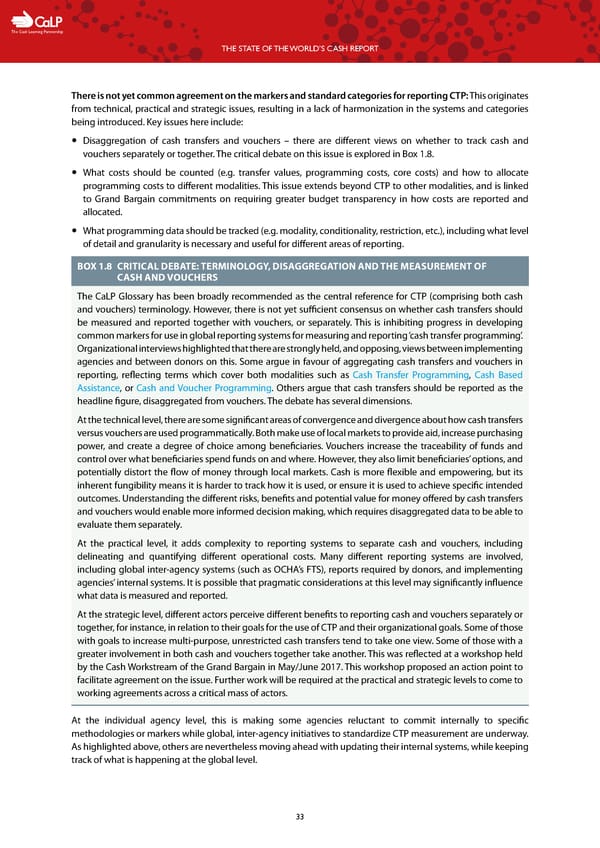C The Cash Learning Partnership THE STATE OF THE WORLD’S CASH REPORT There is not yet common agreement on the markers and standard categories for reporting CTP: This originates from technical, practical and strategic issues, resulting in a lack of harmonization in the systems and categories being introduced. Key issues here include: — Disaggregation of cash transfers and vouchers – there are different views on whether to track cash and vouchers separately or together. The critical debate on this issue is explored in Box 1.8. — What costs should be counted (e.g. transfer values, programming costs, core costs) and how to allocate programming costs to different modalities. This issue extends beyond CTP to other modalities, and is linked to Grand Bargain commitments on requiring greater budget transparency in how costs are reported and allocated. — What programming data should be tracked (e.g. modality, conditionality, restriction, etc.), including what level of detail and granularity is necessary and useful for different areas of reporting. BOX 1.8 CRITICAL DEBATE: TERMINOLOGY, DISAGGREGATION AND THE MEASUREMENT OF CASH AND VOUCHERS The CaLP Glossary has been broadly recommended as the central reference for CTP (comprising both cash and vouchers) terminology. However, there is not yet sufficient consensus on whether cash transfers should be measured and reported together with vouchers, or separately. This is inhibiting progress in developing common markers for use in global reporting systems for measuring and reporting ‘cash transfer programming’. Organizational interviews highlighted that there are strongly held, and opposing, views between implementing agencies and between donors on this. Some argue in favour of aggregating cash transfers and vouchers in reporting, reflecting terms which cover both modalities such as Cash Transfer Programming, Cash Based Assistance, or Cash and Voucher Programming. Others argue that cash transfers should be reported as the headline figure, disaggregated from vouchers. The debate has several dimensions. At the technical level, there are some significant areas of convergence and divergence about how cash transfers versus vouchers are used programmatically. Both make use of local markets to provide aid, increase purchasing power, and create a degree of choice among beneficiaries. Vouchers increase the traceability of funds and control over what beneficiaries spend funds on and where. However, they also limit beneficiaries’ options, and potentially distort the flow of money through local markets. Cash is more flexible and empowering, but its inherent fungibility means it is harder to track how it is used, or ensure it is used to achieve specific intended outcomes. Understanding the different risks, benefits and potential value for money offered by cash transfers and vouchers would enable more informed decision making, which requires disaggregated data to be able to evaluate them separately. At the practical level, it adds complexity to reporting systems to separate cash and vouchers, including delineating and quantifying different operational costs. Many different reporting systems are involved, including global inter-agency systems (such as OCHA’s FTS), reports required by donors, and implementing agencies’ internal systems. It is possible that pragmatic considerations at this level may significantly influence what data is measured and reported. At the strategic level, different actors perceive different benefits to reporting cash and vouchers separately or together, for instance, in relation to their goals for the use of CTP and their organizational goals. Some of those with goals to increase multi-purpose, unrestricted cash transfers tend to take one view. Some of those with a greater involvement in both cash and vouchers together take another. This was reflected at a workshop held by the Cash Workstream of the Grand Bargain in May/June 2017. This workshop proposed an action point to facilitate agreement on the issue. Further work will be required at the practical and strategic levels to come to working agreements across a critical mass of actors. At the individual agency level, this is making some agencies reluctant to commit internally to specific methodologies or markers while global, inter-agency initiatives to standardize CTP measurement are underway. As highlighted above, others are nevertheless moving ahead with updating their internal systems, while keeping track of what is happening at the global level. 33
 The State of the World's Cash | Full Report Page 34 Page 36
The State of the World's Cash | Full Report Page 34 Page 36